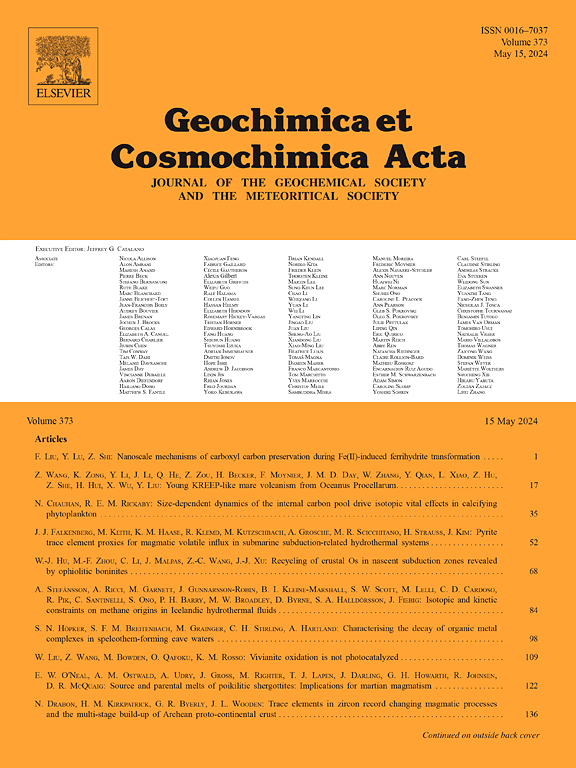月球样品中的镉同位素分馏和中子俘获效应
IF 4.5
1区 地球科学
Q1 GEOCHEMISTRY & GEOPHYSICS
引用次数: 0
摘要
早期对阿波罗月球土壤的开创性研究揭示了地球化学的二分法,反映了mare和highland岩性的优势,以及Procellarum KREEP Terrane物质的可变添加。在这里,我们使用中度挥发性元素镉来确定月球风化层中镉稳定同位素变化的来源和过程。此外,银河宇宙射线(GCR)撞击月球表面产生的113Cd捕获的热中子,为重建风化层的暴露历史提供了一种手段。本文章由计算机程序翻译,如有差异,请以英文原文为准。
Cadmium isotope fractionation and neutron capture effects in lunar samples
Early pioneering studies of Apollo lunar soils revealed a geochemical dichotomy reflecting a dominance of mare and highland lithologies, with variable additions of Procellarum KREEP Terrane material. Here, we use the moderately volatile element cadmium to identify the sources and processes responsible for mass-dependent Cd stable isotope variations in the lunar regolith. In addition, capture of thermal neutrons by 113Cd, resulting from galactic cosmic rays (GCR) impacting the lunar surface, provides a means of reconstructing the exposure history of the regolith.
We report TIMS double spike Cd stable isotope data on samples from the Apollo 12, 16 and 17 missions, consisting of twelve soils of varying maturity, two ferroan anorthosites, and orange glass 74220. Cadmium abundances are generally lower in mare (12 to 79 ng/g) than highland soils (∼70 to 95 ng/g). Cadmium stable isotope compositions, expressed as ε112/110Cd, display a larger range in mare (∼0 to + 106) than in highland (+60 to + 97) soils. The two anorthosites exhibit contrasting ε112/110Cd values (−107 vs. + 47) and Cd concentrations similar to those of highland soils. Orange glass 74220 is Cd-rich (290 ng/g) and has a light Cd isotopic composition (ε112/110Cd = -27) due to condensation of Cd vaporized during lava fountaining.
A broad trend of decreasing Cd abundance and increasing heavy isotope enrichment with increasing maturity is observed for mare soils but is not apparent for the highland soils. These characteristics might arise from space weathering, including micrometeorite bombardment, but simple mass balance indicates that meteoritic addition has a negligible effect on the lunar regolith Cd. Likewise, neutron capture on 113Cd tends to increase with maturity in mare soils while being greater and relatively uniform in highland soils, reflecting a longer exposure history and more extensive reworking of the highland regolith. Neutron capture effects were not resolved for immature mare soils, orange glass and one anorthosite, indicating these samples experienced only short near-surface exposure to GCR.
The relationships between Cd abundances and isotope effects reveal three distinct correlations for the highland soils and the mature and immature mare soils, respectively. These are best explained by simple binary mixing between isotopically distinct components. The “heavy” Cd components of mare and highland soils have variable but overall low Cd contents while the cadmium-rich component is always isotopically “light”, and common, at least, to all mare soils. The strong correlation between Cd stable isotopic composition and neutron capture effects in mare soils constrains the ε112/110Cd of the neutron capture-free component to be −4.9 ± 2.3, that is marginally lighter than that of the Bulk Silicate Earth (0.01 ± 0.94). This component is predominantly found in immature, KREEP-rich soils that were not exposed to GCR. This supports an origin as exhumed material, possibly from the relatively recent Copernicus Crater, and/or as vapor re-distributed over the lunar surface. The ubiquitous presence on the Moon of a cadmium-rich reservoir and its apparent isotopic similarity with the BSE requires further scrutiny for a critical evaluation of its significance and implications for the bulk Moon composition.
求助全文
通过发布文献求助,成功后即可免费获取论文全文。
去求助
来源期刊

Geochimica et Cosmochimica Acta
地学-地球化学与地球物理
CiteScore
9.60
自引率
14.00%
发文量
437
审稿时长
6 months
期刊介绍:
Geochimica et Cosmochimica Acta publishes research papers in a wide range of subjects in terrestrial geochemistry, meteoritics, and planetary geochemistry. The scope of the journal includes:
1). Physical chemistry of gases, aqueous solutions, glasses, and crystalline solids
2). Igneous and metamorphic petrology
3). Chemical processes in the atmosphere, hydrosphere, biosphere, and lithosphere of the Earth
4). Organic geochemistry
5). Isotope geochemistry
6). Meteoritics and meteorite impacts
7). Lunar science; and
8). Planetary geochemistry.
 求助内容:
求助内容: 应助结果提醒方式:
应助结果提醒方式:


